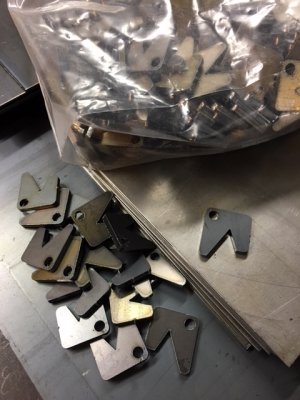A couple of reasons John.
First and foremost the 3/16 hole diameter is too small for consistently good results from plasma. It's at the edge of what CAN be done, but is too close to the edge of plasma's capabilities to produce consistently good results. Also, I need a super smooth ID on these holes as they must free fall around a fastener, so I can't have any internal ripples.
@PeterT referred to a localized "hardening" process that occurs with laser, and he is 100% correct. It's problematic if tapping—but really, really, useful if your hole needs to pivot around a fastener like mine does. In my case, if that rippled hole gets caught up on a slight edge and fails to fall with gravity, that's a problem for my customers. The head on the fastener is only mm larger than the hole, so slight deviation could prove a problem. But the clean cut of laser and localized hardening works in my favour if you are aware of the process.
Plasma is great for many, many things, but this isn't one of them. Plasma excels at long runs cuts at the same speed. Tweaking the software for small holes is possible, but consumable wear, plate condition, etc, can throw this all out the door. If cutting several inches or several feet with even gradual curves, plasma is economical and a great choice. But tight stuff, while possible, is an exercise in frustration; it's too many variables. Even if you do get it right, the smallest change in your plate, finish, air, consumable, etc., means you can't replicate it again without adjustments. Fine for one-offs of course...not so so great for 1000 parts.
But the bigger problem is dross clean-up. On large pieces such as one-off silhouette art, this is no biggie. But on a bunch of small pieces like this, it's labour intensive to the point that you lose money. In a nutshell, it's a lot of wire brush work that kills my profit margin.
In the past five years I've refined a few of my patented parts such that I don't need to finish them manually. By matching the appropriate cutting technique (plasma, laser, water jet), with the finishing technique, I've managed to make a profit (mostly). Actually, I kind of enjoy the spreadsheet side of metal working. I remember the moment when I started to understand the business side of this stuff: a fabrication shop I had asked to plasma cut parts for me 12 years ago said, "Are you NUTS? You can't afford the finishing on this. Let's laser them instead. You just remove the tabs yourself."
I'm a big fan of vibration tumbling for larger part runs. I used to have a 50 lbs. tumbler but sold it. I've borrowed a smaller one for this parts run and already got the media. I'll post some videos when I tumble these. One-offs are no big deal to clean up, but for larger runs you can marry the cutting process with media (ceramic, walnut, etc., and the media size), to de-burr, polish, etc., and save 100's of hours.
I've made a few tumblers over the years, but there are so many well made ones available for cheap now, it's not worth it to construct, other than for the fun factor.
Other forum members may have different experiences, but I've learned that picking the correct process is the key to success with repetitive parts. One-offs are another matter—and I am as guilt as others as doing something for the shear fun and eduction factor.
Does this help John?

